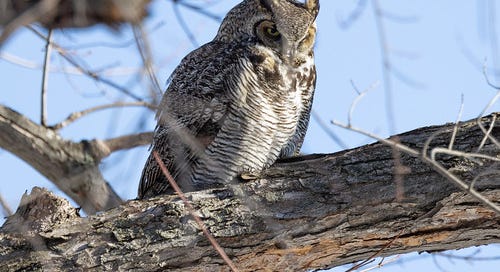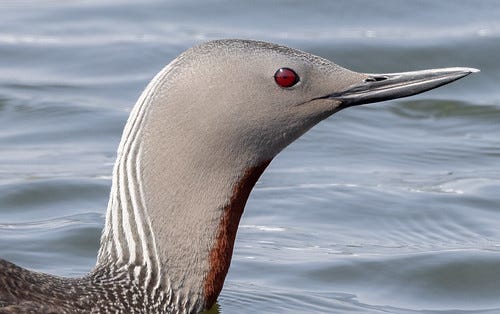(Listen to the radio version here.)

Every night at dinnertime I swallow rat poison, something I’ve been doing since my second heart attack in 2020. Warfarin raises the time it takes for my blood to clot, making it much less likely that a clot can spontaneously form in a pesky congenital aneurism on my right coronary artery. Since I don’t have any serious blockages, this is the only treatment I’ve needed to prevent another heart attack. So far, so good.
Of course, I don’t pick up that rat poison on the streets, as hapless rodents do, nor indirectly, as even more hapless scavengers and predators do. I take it in the form of a little blue pill or, two days a week, half a pill, and I test my blood’s clotting rate every other Friday morning on a home test monitor, which instantly sends the results to my warfarin clinic. If the number is higher or lower than it should be, a nurse calls within minutes to adjust my dose. Before my recent surgery, I had to stop taking it for five days and wait to resume taking it a day or two after surgery so that I wouldn’t bleed out.
Even when my clotting rate is exactly right and I’m not being operated on, I’m in far greater danger than most people of hemorrhaging or even bleeding out from minor injuries. I’m supposed to head directly to Emergency if I hit my head—even a light bonk could, in a matter of days, render me blind or outright dead.
I’ve taken two pretty big spills in the past two years—on a dock in Anchorage, Alaska, when I was photographing a Red-throated Loon two years ago, and off my bike last fall when a car crowded me in the bike lane. I didn’t hit my head either time, but the bruising on my leg and hand was much more intense and lasted way, way longer than it would have had I not been on warfarin. I broke my pinkie on the bike fall, and even after the bone mended, it took months for the finger to be a normal flesh color again. Bathtub falls are extremely dangerous for anyone, and so I’ve taken to traveling with a rolled-up bathtub mat for slippery motel showers. Warfarin is a genuine miracle drug that has saved millions of lives, but it’s nothing to play around with.
The story of warfarin began in 1933, when a farmer named Ed Carlson drove through a blizzard from northwest Wisconsin to Madison with a dead cow, a pile of moldy hay, and a milk jug full of blood. The cow had died from a mysterious condition called “sweet clover disease,” which had been studied by researchers in North Dakota in the 1920s, but all anyone knew was that something in moldy clover caused animals who ate it to hemorrhage or bleed out. Ed Carlson needed more than a name for the condition—he needed to know how to protect his animals. It took six years for the scientists to isolate a crystalline chemical in the moldy hay that prevented blood from clotting. By 1941, the scientists realized that this chemical could be useful in two entirely different and ironically opposite ways, killing rodents while preventing dangerous blood clots in vulnerable humans.
The Wisconsin Alumni Research Foundation (WARF—they also funded my husband’s Ph.D. research!) funded their research into synthesizing the drug and working out therapeutic levels. It seemed so extremely counterintuitive for a medicine to also work as rat poison that they started calling the warfarin sold as a blood thinning medicine by another name, Coumadin. It got a big PR boost when President Dwight Eisenhower had a heart attack while in office and became warfarin’s most famous patient.
In its original form, warfarin is still extremely important therapeutically, but as a rodent poison, it lost effectiveness as the mice and rats that did survive reproduced, ultimately leading populations to develop resistance. Second generation compounds, which came to be called “superwarfarins,” proved more lethal to them, but the original warfarin is what continues to be used in human medicine.
Warfarin, superwarfarins, and other rat poisons remain in an animal for a long time, and any predators or scavengers who eat a poisoned rodent also ingest the insidious poison. Eating just one poisoned rat could make a hawk or owl vulnerable to bleeding or internal hemorrhaging from the minor injuries predators naturally deal with when tangling with resistant prey. When they eat poisoned rodents day after day, with no warfarin clinic to monitor their clotting rate, they’re in big trouble.
When Flaco, the famous Eurasian Eagle Owl a vandal set loose from the Central Park Zoo, died, the necropsy showed he’d been exposed to four different anticoagulant rodenticides. And sure enough, his poor body showed substantial hemorrhage under the sternum and in the back of the body cavity around the liver, and a small amount of bleeding behind the left eye without evidence of head trauma.
Barry the Barred Owl, another famous New York City predator, was also necropsied after she collided with a slow-moving vehicle in Central Park. Sure enough, her body showed heavy loads of rat poison, too. Necropsies of several Red-tailed Hawks found dead in New York also showed that they carried lethal levels of rat poisons.
This week, the Chicago Bird Alliance posted on Facebook:
I am sorry to report that our beloved baby great horned owl who hatched from the breeding pair at North Pond this year was found dead yesterday morning. He went to Willowbrook Wildlife for a necropsy to determine cause of death, which is presumed to be rodenticide poisoning, the same cause of his father’s death in early April. The remaining female owl was seen yesterday with new active bleeding from a previously scabbed foot wound and has not been seen today so it is feared she may have also ingested poisoned prey.
For any birders visiting North Pond, if you spot the female owl appearing unwell or dead, please call Chicago Bird Collision Monitors ASAP. If she is dead, please pick her up and keep her if possible so someone else or a predator doesn’t get her until a CBCM volunteer can pick her up to be taken to Willowbrook Wildlife.
A sobering reminder this week, on the heel’s of Mondays Chicago Bird Alliance meeting to discuss use of rodenticide poisoning in our city.
Rats are obviously dangerous pests, but it’s our filthy habits that lure them to cities in the first place, and judging by the number of rats I’ve seen when visiting my daughter in New York, rat poisons have been ineffective at solving the problem, making the collateral damage to hawks and owls even more unconscionable.
Rats are obviously dangerous pests, but it’s our filthy habits that lure them to cities in the first place.
Flaco, Barry, and the Chicago Great Horned Owls were known individuals being tracked by many people. Untold numbers of hawks and owls who are not recognized individuals die without making the news, and we humans blithely go through our lives without recognizing how many creatures are suffering and dying because of rat poison. When my daughter and I walked her dog in her Brooklyn neighborhood back before the pandemic, we kept close watch for both dead rodents and the poisoned bait we saw here and there. Protecting Muxy was our immediate problem, so most of the time, I didn’t even think about the collateral damage birds were facing, no vigilant humans right there to protect them.
When she read about the Chicago owls’ deaths this week, my dear friend Laurie Gilman from Maine wrote, “Heartbreaking that poison is so commonly and carelessly used. These beautiful souls did not need to die.”
Yep. That says it all.
“Heartbreaking that poison is so commonly and carelessly used. These beautiful souls did not need to die.”
—Laurie Gilman





